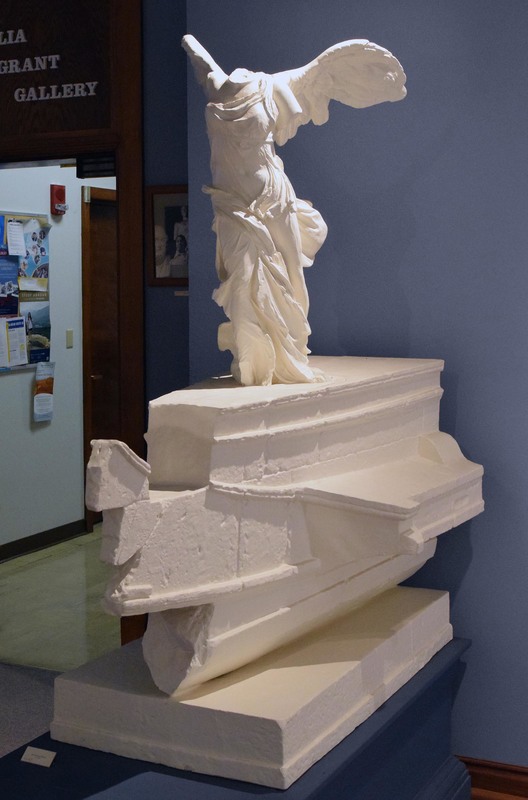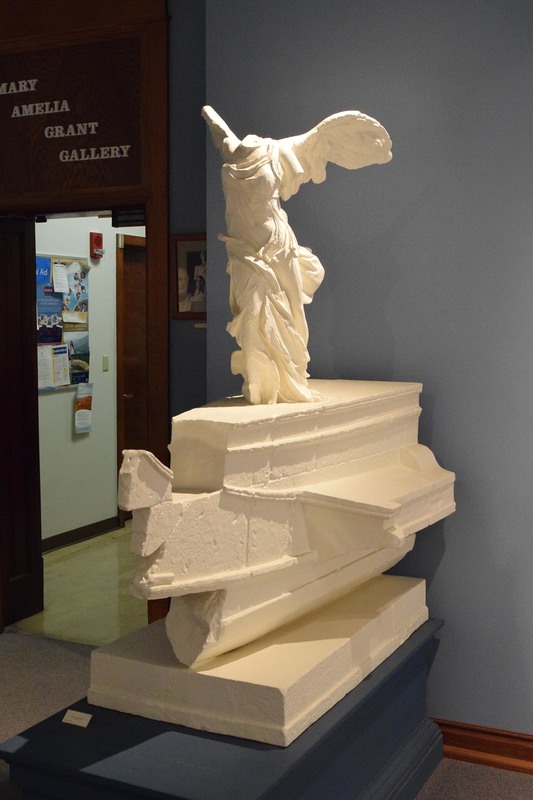-
Title
-
Nike of Samothrace
-
Description
-
Introduction
The Wilcox Collection has a reduced copy (about 1:3) of the figure of Victory (Greek Nike/ Roman Victoria) discovered in 1863 on the island of Samothrace in the northeast Aegean. The original, of Parian (Greek island) marble, is now in the Louvre Museum in Paris. Inventory no. 2369. She stands 2.45 m. tall (8 ft. 1 in.) and is missing the arms, head, and portions of drapery. Several fragments of the hands have been found which are not included in the restoration or in our cast (these are now housed in the Kunsthistorisches Museum in Vienna); the hands did not hold anything (cf. the coin of Demetrios Poliorcetes discussed & illustrated below). The base is of a different marble, from Rhodes, another Greek island in the southeast Aegean.
Date and Sculptor
The statue is problematic: although all scholars consider it a "baroque" work of the Hellenistic period (323- 30 B.C.), the exact date of the statue is uncertain, perhaps 190-80 B.C. Some scholars consider it a work by an artist from the island of Rhodes, because other naval monuments are known from that island; an inscription from Samothrace naming Pythokritos of Lindos on Rhodes perhaps strengthens the otherwise hypothetical connection.
Setting
In its original location on Samothrace, the statue was part of a public sculptural ensemble that was located above the seating area (cavea ) of a theater at the site. The monument depicts Nike herself and the prow of the ship on which she alights, set in a basin filled with water with roughhewn rocks to suggest the seashore.
Description
The sculptor has shown a figure still in flight, alighting on the prow of the ship; she appears almost unbalanced, with the right leg advanced and the left trailing, with a shift in weight at the waist and a slight turn of the torso to the right. The figure wears a cloak (himation) and long dress (chiton) with an over fold, belted high under the breasts, a typical Hellenistic style (some of the female figures on the Pergamon Altar, ca. 150-130, wear similar garments). The drapery appears to have a life of its own, outlining the breasts and abdomen (even the navel) and cascading between the legs with folds fluttering behind the body. By modern standards of beauty, the body of the goddess appears heavy, with full hips and thighs. To a certain extent, the outstretched wings (note the detail of the individual feathers) would have compensated and helped to balance the figure, especially when it was seen in its original position, elevated above the crowd in the theater and silhouetted against the sky.
Victory Theme in Ancient Art
Nike/Victoria was a common figure in Greek and Roman art because of her association with military victory. Earlier representations of the goddess are known by the sculptor Paionios, which stood on a pillar at Olympia, and the temple of Athena Nike on the Akropolis at Athens. A life-sized Nike (now completely lost) stood on the outstretched right hand of the immense gold and ivory statue of Athena in the Parthenon (ca. 432), who herself stood 30-40 feet tall. Nike was also a popular figure for akroteria, statues that stood at the upper corners of the roof or on the peaks of Greek temples.
Other Ancient Naval Monuments
Other naval monuments that featured Victory figures were more widespread in antiquity than people have realized generally. For example, a coin minted under king Demetrios Poliorcetes (between 306 and 283) shows a Nike similar to the Nike of Samothrace, alighting on the prow of a ship to commemorate a naval victory; the goddess appears in profile with wings, now folded, and holding a trumpet to her lips to sound the victory. It was once A forerunner to the Samothrace Nike is a naval monument at Cyrene in North Africa. The now headless, wingless figure (Nike or Athena?) alights on the prow of a ship. The monument may have been erected 246-241 as a victory monument for Ptolemy III Euergetes of Egypt. The most famous Roman statue of victory was the gilded bronze figure taken from Taranto, in south Italy, and displayed standing on a globe in the Senate House in the Rome. The statue survived until the 5th c. C.E. thought, in spite of the differences in the rendering of the wings, that the Poliorcetes coin depicted the Nike of Samothrace, but her hands, recently discovered, reveal that they held nothing.
-
Bibliography
-
Bieber, M. 1955. The Sculpture of the Hellenistic Age rev. ed. (New York) 125-26, figs. 493-96.
Ermeti, A.L., and S. Stucchi. 1981. L'Agora di Cirene III.1. Il monumento navale (Rome) 107 ff, pls. 13-21.
Frederiksen, R., et al., The Cast Gallery of the Ashmolean Museum (Oxford 2011), 111, B140a.
Hamiaux, M. 1998. Les Sculptures Grecques, II. La période hellénistique (IIIe-1er siècles avant J.-C.) (Paris) 27-40. [storeroom fragments not included in the reconstruction].
Haskell, F. and N. Penny. 1981. Taste and the Antique. Lure of Classical Sculpture 1500-1900 (New Haven and London), pp. 333-335, cat. 92.
LIMC VI.1.850-904 (Nike). [LIMC = Lexicon Iconographicum Mythologiae Classicae (a comprehensive myth and art encyclopedia: a copy is available in the reference section of Spencer Art & Architecture Library at KU]
Lullies, R., and M. Hirmer. 1957. Greek Sculpture (London) pl. 248.
Mark, I. 1998. "The Victory of Samothrace," in Palagia, O., and W. Coulsen, eds. Regional Schools in Hellenistic Sculpture (Oxford) 157-65.
Moreno, P. 1994. Scultura ellenistica I (Rome) 366-69.
Pollitt, J. 1986. Art in the Hellenistic Age (Cambridge) 113-16, 115 fig. 117.
Robertson, M. 1981. A Shorter History of Greek Art (Cambridge) 194 fig. 274.
Ridgway, B.S. 1990. Hellenistic Sculpture II.The Styles of ca. 331-200 B.C. (Madison) 150-57, pl. 48.
Stewart, A. 1990. Greek Sculpture. An Exploration (New Haven) 77-78 (on costume).
-
Date Created
-
1863
-
Iconography
-
Nike
-
Victory
-
Findspot
-
Samothrace


